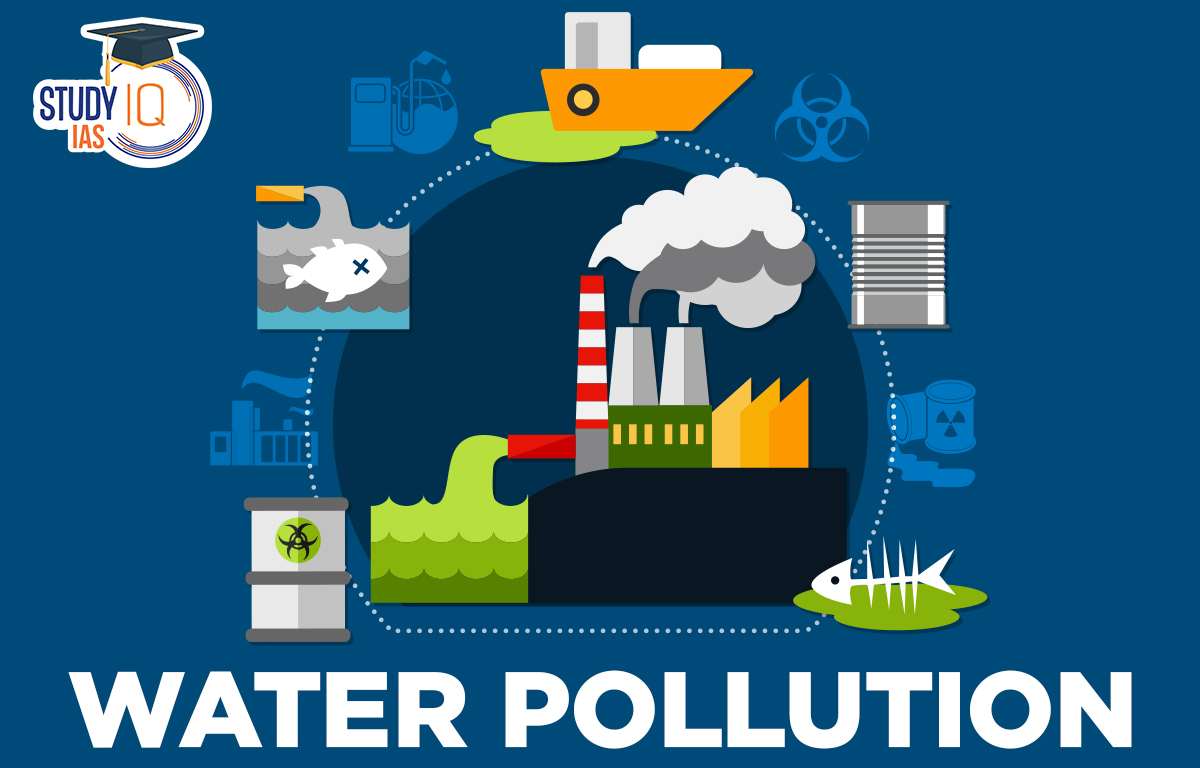Table of Contents
Water pollution
Water pollution is a major problem that affects everyone on Earth. Water is essential for drinking, cleanliness, farming, and transportation. It can dissolve more substances than any other liquid, making it important for our bodies and health. Despite its importance, there is a serious global water crisis. According to UNESCO, 2 billion people lack safe drinking water, and 3.6 billion do not have proper sanitation. This is mainly due to pollution and the deterioration of our water sources like lakes, rivers, and oceans. We need to act quickly to understand and solve the causes of water pollution.
Water Pollution is an important part of Environment and Ecology which an important subject in UPSC Syllabus. Students can also go for UPSC Mock Test to get more accuracy in their preparations.
Water Pollution Meaning
Water is one of the most important resources on our planet and has been around for a very long time. Some of the water we drink today has existed since the time of the dinosaurs!
More than two-thirds of the Earth is covered in water, which adds up to about 1 octillion liters (that’s 1,260,000,000,000,000,000,000 liters). Most of this water is in oceans, rivers, lakes, and streams. Only about 0.3% can be used by people. This small amount is decreasing because of pollution and outdated practices.
According to the World Health Organization (WHO), polluted water is water that has changed so much that it can’t be used safely. This type of water can harm farming and spread diseases like cholera, dysentery, and typhoid, which kill over 500,000 people every year.
The main causes of water pollution include bacteria, viruses, parasites, chemicals, plastics, waste, and pesticides. Many of these harmful substances are invisible and don’t change the water’s color, so we need to test small samples to check the water quality.
Read about: Tributaries of Ganga
Water Pollution Causes
Sewage Water
Sewage water comes from homes and other buildings. It includes waste from people and animals, leftover food, and cleaning products like detergents. Hospital and regular sewage can contain harmful germs that can make us sick.
Dissolved Oxygen (DO)
Pollutants in water lower the amount of dissolved oxygen (DO). If the DO level is less than 8.0 mg/L, the water may be polluted. A DO level below 4.0 mg/L is considered very polluted. Dissolved oxygen is important for fish and other water animals to live. Several things can affect DO levels, such as how much the water is moving, how plants make oxygen through sunlight, and how much oxygen is used by living things and decaying materials. When there is more waste, it breaks down faster and uses up more oxygen, reducing the DO level in the water.
Biological Oxygen Demand (BOD)
Biochemical oxygen demand (BOD) measures how much organic waste is in water. It tells us how much oxygen bacteria need to break down this waste. BOD is measured in milligrams of oxygen for each liter of water. A higher BOD value means there is less dissolved oxygen in the water. However, BOD isn’t the best way to measure water pollution because it only works for waste that can break down naturally.
Chemical Oxygen Demand (COD)
A accurate method for determining the pollution load in water is chemical oxygen demand (COD). According to COD, the amount of oxygen needed to oxidize organic (both biodegradable and non-biodegradable) and oxidizable inorganic molecules in a water sample is measured in parts per million.
Industrial Wastes
Discharge of wastewater from industries such as oil and gas, paper production, metal extraction and processing, chemical manufacturing, etc in particular heavy metals (classified as elements with density > 5 g/cm3 such as mercury, cadmium, copper, lead, arsenic) and a variety of organic compounds, which commonly contain dangerous chemicals.
Marine Pollution
All pollutants, whether natural and man-made, are absorbed by the oceans. Also, the rubbish and sewage from coastal cities are dumped into the ocean. The discharge of oil and grease; detergents, sewage, rubbish, and radioactive wastes; offshore oil mining; and oil spills are some of the additional sources of ocean pollution.
Oil Spills
Leakage during marine transport and leakage from underground storage tanks are the two most frequent causes of oil spills. During offshore oil production, an oil spill could happen.
Read about: Rivers of India
Water Pollution Effect
Reduces the Level of Dissolved Oxygen
Dissolved oxygen (DO) is the amount of oxygen in water, and all living things need enough of it for good water quality. When there are pollutants in the water, the level of dissolved oxygen goes down. These pollutants can come from factories, farm runoff, city water, and the destruction of plants along rivers, as well as other sources.
Increases BOD
Biological oxygen demand (BOD) measures how much oxygen bacteria need to break down organic waste in water with oxygen. The more organic waste there is, the more oxygen the bacteria need. This means that BOD shows how polluted the water is.
If there is too much pollution, the water loses oxygen, which can kill fish and other aquatic life. Then, bacteria that don’t need oxygen start to break down the waste, creating harmful substances and bad smells.
As aerobic bacteria break down the waste, they use up the dissolved oxygen in the water. So, higher BOD levels indicate more oxygen is needed for this process. When sewage mixes with river water, BOD levels go up.
Increases Chemical Oxygen Demand (COD)
Chemical oxygen demand (COD) is the amount of oxygen needed to break down organic matter in water. If treated wastewater is released into nearby water, it can still add organic materials. High COD levels show there is a lot of organic matter, which can reduce dissolved oxygen in the water and harm the environment.
Eutrophication
Eutrophication is when there are too many nutrients, like nitrogen and phosphorus, in water. This can lead to problems such as low oxygen levels and poor water quality, which harm fish and other animals.
The main causes are rivers that flow into the ocean, fertilizers used in farming, waste from animals, and human trash. Too many of these nutrients can reduce oxygen in the water and create “dead zones” where no life can survive.
Ocean Acidification
This happens when human activities release carbon dioxide into the air. When this carbon dioxide dissolves in the ocean, it lowers the water’s pH and makes it more acidic. Ocean acidification can harm marine life by causing problems with their health and making it harder for shellfish and other sea creatures to grow their calcium carbonate shells.
Read about: Indus River System
Water Pollution & Effects
- Domestic and medical waste can contain harmful bacteria. Dumping it into water without treatment can cause diseases like cholera and typhoid.
- Industrial waste contains metals like lead, zinc, arsenic, copper, mercury, and cadmium, which harm humans and animals.
- Drinking water with arsenic can cause skin problems and cancer.
- Mercury in water turns into a toxic form that can cause numbness, hearing loss, vision problems, and mental issues.
- Lead poisoning can cause anemia, headaches, muscle weakness, and gum problems.
Cadmium: Cadmium in water can cause painful bone and joint disorders, and cancers of the lung and liver.
Read about: Indian Ocean
Water Pollution Preservation
Wastewater Treatment
Pollutants in wastewater are removed through a physical, chemical, or biological process during the wastewater treatment process. These techniques are increasingly successful as the water becomes cleaner.
Green Agriculture
It is important to have climate-friendly crops, efficient irrigation that uses less water and energy-efficient food production because agriculture uses 70% of the fresh water in the globe. Green agriculture is also crucial to lowering the amount of contaminants that enter the water.
Storm Water Management
The US Environmental Protection Agency (EPA) says storm water management means trying to reduce the rain or melted snow that flows into streets and yards, while also making the water cleaner. It’s important to keep pollution out of the water to use it more efficiently.
Air Pollution Prevention
Air pollution affects water pollution because oceans take in 25% of the carbon dioxide (CO2) that we produce. This makes the oceans more acidic, which hurts corals and other sea life. The best way to protect our oceans is to reduce air pollution.
Plastic Waste Reduction
In our oceans, 80% of the plastic comes from land. If we want to reduce the amount of plastic entering our oceans, both the global consumption of plastic and the management of plastic waste must be improved.
Water Conservation
- Without saving water, humans can not progress. It is important to provide clean water globally by managing it well and knowing it is limited.
- Treat sewage before releasing it into water bodies to reduce toxicity. Treated water can be used in toilets and farms.
- This plant can absorb harmful chemicals like cadmium. Planting it in polluted areas can help reduce pollution.
- Techniques like precipitation, ion exchange, reverse osmosis, and coagulation help manage water pollution.
- Reuse, reduce, and recycle water to help combat pollution.
Water Pollution UPSC
According to the definition of water pollution, it occurs when water sources are contaminated with contaminants that render the water unfit for swimming, cleaning, cooking, and other uses. Chemicals, garbage, bacteria, and parasites are examples of pollutants. Beyond surface water, groundwater, the ocean, and the sea have all been affected by water pollution. Students can read all the details related to UPSC by visiting the official website of StudyIQ UPSC Online Coaching.
Read about: Indian Ocean Dipole


 Repo Rate and Reverse Repo Rate, Impact ...
Repo Rate and Reverse Repo Rate, Impact ...
 Foreign Contribution Regulation Act (FCR...
Foreign Contribution Regulation Act (FCR...
 Urban Cooperative Banks in India, Functi...
Urban Cooperative Banks in India, Functi...





















